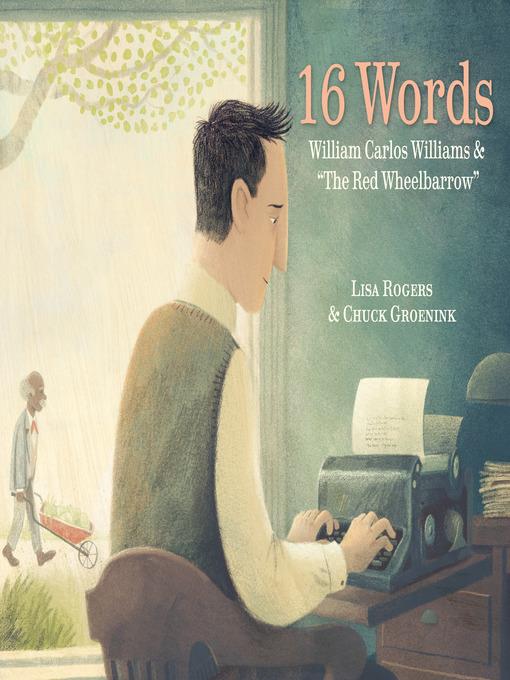
16 Words
William Carlos Williams and "The Red Wheelbarrow"
فرمت کتاب
ebook
تاریخ انتشار
2019
Lexile Score
850
Reading Level
2-5
ATOS
4
Interest Level
K-3(LG)
نویسنده
Chuck Groeninkشابک
9781524720186
کتاب های مرتبط
- اطلاعات
- نقد و بررسی
- دیدگاه کاربران
نقد و بررسی

Starred review from July 8, 2019
“Look out a window. What do you see?” An invitation to notice sets the tone for this compelling story of how an iconic poem by William Carlos Williams (1883–1963) came to be, conjuring the specific people, places, things, and perspective that coalesced into his 16-word verse. We meet Dr. Williams, busy treating patients and delivering babies, and African-American Thaddeus Marshall, the neighbor who owns the wheelbarrow—“He depends on the wheelbarrow to carry the vegetables he sells to his neighbors.” The fact that Marshall is a gardener “who has been ill” deepens the poem’s context, as does Williams’s process as an artist who “fits in his writing around his doctoring.” Telling details in Groenink’s thoughtful illustrations amplify the importance of observation: Marshall pushes his wheelbarrow up the street as Williams, seen through a window, types; plums, a fire truck, and a cat nod to his other poems. Williams’s koanlike poem closes the story, its marvel of compacted meanings crystallizing everything that has come before. Ages 4–8.

Starred review from July 15, 2019
The fictionalized backstory behind William Carlos Willams' most famous poem. In her picture-book debut, Rogers teams up with Groenink to offer a glimpse of William Carlos Williams' intriguing life and to imagine what may have inspired his signature poem, "The Red Wheelbarrow": "so much depends / upon / a red wheel / barrow / glazed with rain / water / beside the white / chickens." Written in 1923 in suburban northern New Jersey, this 16-word free-verse lyric helped establish the family physician/poet as a beacon of 20th-century American imagist poetry. Here Rogers saves this compact, kid-friendly poem as the finale to her clever, biographically rooted close reading, in which she explores what exactly depends upon that wheelbarrow: namely the livelihood of gardener Thaddeus Marshall, Williams' neighbor, and those fed by the vegetables the wheelbarrow helps him deliver--and Williams' yearning to create art. Rogers not only calls attention to the objects included in the poem, but pointedly notes what was omitted: "Those sixteen words...do not describe Mr. Marshall's life of work or caring or love. But somehow they say just that." Groenink's richly layered, chalky illustrations expressively realize in muted earth tones the all-important everyday elements of Williams' world. They reveal Marshall to be black--one of few people of color living alongside the mostly white population of Rutherford, New Jersey. At once spare and lush: a gorgeous introduction to the power of poetry. (author's note, further reading) (Picture book/poetry. 3-8)
COPYRIGHT(2019) Kirkus Reviews, ALL RIGHTS RESERVED.

September 1, 2019
Gr 2-6-Rogers delves into the larger story behind William Carlos Williams's famous poem "The Red Wheelbarrow," opening a window into the poet's life and inviting children to consider what lies beyond those simple 16 words. As a physician in Rutherford, NJ, in the 1920s, Williams is depicted as treating both black and white patients. One of those patients, Mr. Thaddeus Marshall, is the owner of a red wheelbarrow, which he uses to take vegetables from his garden to sell to neighbors. Marshall and the wheelbarrow are a part of the daily landscape until the patient becomes ill. In the story, Williams ponders the significance of the wheelbarrow sitting empty as rain falls on the garden. While the main narrative imagines how Williams may have come to write the poem, an author's note provides the factual basis and insight into Williams as a person. The author asks readers to consider what the poem means to them and provides a framework for studying any piece of poetry. Full-bleed digital illustrations are interspersed with smaller spot images. Decorative elements in the houses, buildings, wallpaper, and design elements such as family photos present a visual sense of the time period. VERDICT A unique picture book that shows how poetry can capture a feeling or an image with a few well-chosen words. Pair with Sharon Creech's Love That Dog to make a thought-provoking poetry connection.-Lucinda Snyder Whitehurst, St. Christopher's School, Richmond
Copyright 2019 School Library Journal, LLC Used with permission.

September 1, 2019
Grades K-2 This quiet, homey picture-book biography of William Carlos Williams is a great introduction to writing and the appreciation of poetry. The text gently ambles along, portraying life in the small, quiet neighborhoods where Williams served as a town doctor, detailing his observances of normal, everyday things as he went from patient to patient, making house calls. The digital illustrations employ muted colors reminiscent of old sepia photographs, adding to a quaint, old-timey feel. The 16 words referenced in the title refer to the entirety of one of Williams' best-loved poems, "The Red Wheelbarrow," a description of a neighbor's garden on a rainy day. Kids will get a feel for how Williams found inspiration, jotted down lines whenever he could, and used simple language. The text also talks about how Williams doesn't load his lines with lots of imagery yet manages to convey his ideas to readers with just a few words. Great for reading aloud, this will also be a good choice for launching poetry units and inspiring neophyte poets.(Reprinted with permission of Booklist, copyright 2019, American Library Association.)

























دیدگاه کاربران